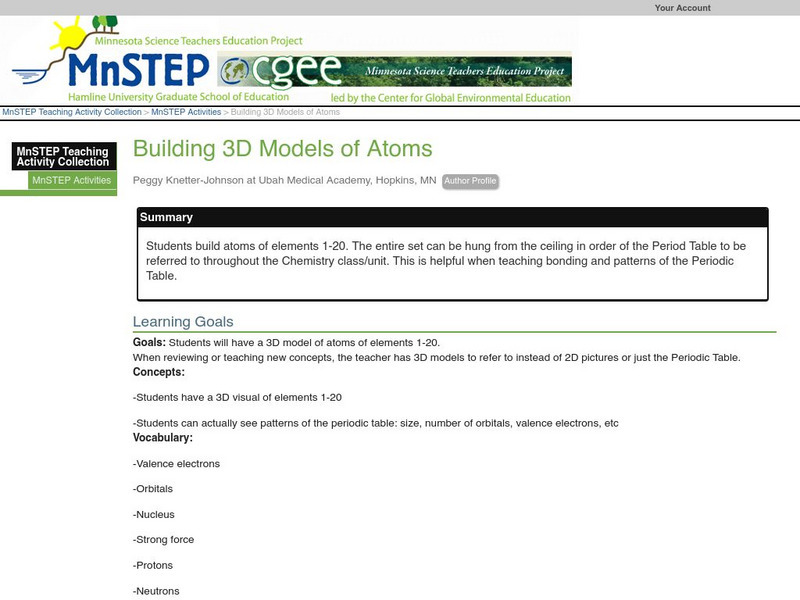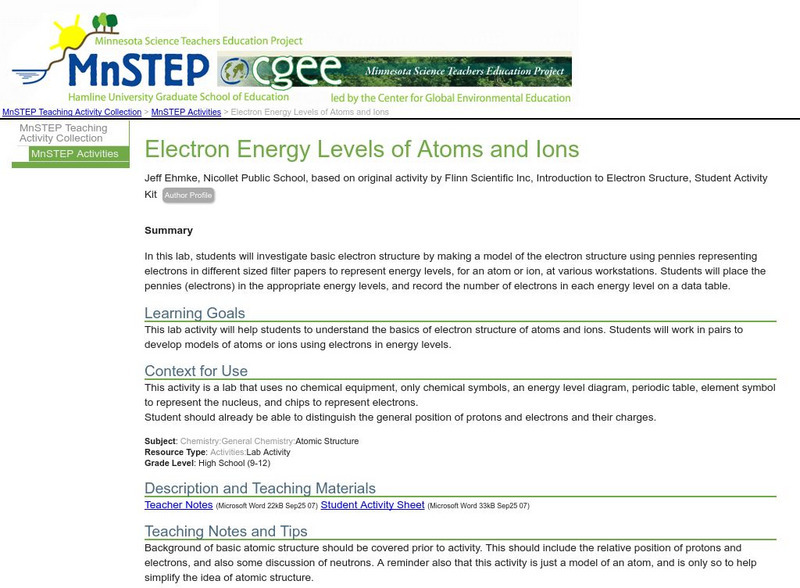Curated OER
Causal Patterns in Density Phenomena
Students consider the causes of density at a microscopic level. They then discover that one cause of density has to do with how many protons and neutrons the material contains.
Curated OER
Physical and Chemical Changes
Eighth graders view a PowerPoint presentation that assist them in distinguishing between physical and chemical changes. They compare their observations of demonstrations to a list of clues recognizing types of changes.
Curated OER
Using several learning modalities to teach about the Periodic Table.
Pupils identify how to relate the position of an element in the periodic table to its atomic number and atomic mass. They identify how to use the periodic table to identify metals, semimetals, nonmetals, and halogens, and also, alkaline...
Curated OER
Energy Dispersive Spectroscopy
Students calculate the values of electron binding energies. In this physics lesson, students solve for different wavelength characteristics of X-rays. They present their findings to the class.
Curated OER
Reading Labels For Fat Types
Learners analyze a variety of cooking oils to determine the amount and types of fats included in each.
Curated OER
Static Cling
Students work together to discover the concept of static electricity. They participate in an experiment in which they test different objects charge. They make observations and record them for later use.
Curated OER
Blast's Cosmic Carnival
Learners, after analyzing the history of a concentrator, model how a Genesis spacecraft concentrator works by playing a game. In groups of three or four, after being given materials to work with, are challenged to roll the rubber balls...
Curated OER
Ethical Decision Making in Biology
Students explore a model that illustrates the spread of HIV through an adolescent population. Acting in the role of epidemiologists, students explore the dilemmas of HIV infection presented by a simulation. Students produce a play, skit,...
Curated OER
Using Radioactive Decay To Determine Age
Students explore the process of carbon dating fossils to determine their age. They simulate radioactive decay using pennies in a shoe box. Heads represents a decayed atom each time they shake the box. They use the data to calculate the...
Curated OER
Pauli's Magical Water
Students predict the shape of molecules using VSEPR theory. In this chemistry lesson, students differentiate a polar and nonpolar molecule. They discuss why water's polarity is very important.
Curated OER
Atomic Time Lines
Students understand the evolution of the atomic model from Ancient Greece to the present. They then choose one of the options as a project using class time to do research and to be creative.
Curated OER
Lesson- Radial Solution, Hydroggen Wavefunction
Student uses Schrodinger's equation applied to a single electron Hydrogen atom. They use angular and radial portions equation to answer questions. Student use a model to answer equation questions.
Curated OER
Code Makers - Electron Configuration, Aufbau Principle
Students write the electron configuration of elements using the Aufbau principle. In this chemistry lesson, students build their own key that demonstrates the principle.
Curated OER
A Chemist in My Class?
First graders in kindergarten science class discuss matter. They make predictions and then identify mystery items in brown paper bags as either solid, liquid, or gas by using their senses. They discuss that a chemist is a scientist that...
Curated OER
Breaking it Down
High schoolers will identify the factors that contribute to erosion and weathering. They will start by differentiating between chemical and mechanical weathering. They then apply what they learned by playing the online jeopardy game. Key...
Alabama Learning Exchange
Float or Sink?
Experiment with mass and density as scholars figure out what makes things float or sink. First, they watch a podcast introducing these concepts. Be sure to use the comprehension question to test their understanding. Young scientists...
Curated OER
Grating Spectrometer
Students calculate the Balmer series. For this physics lesson, students observe hydrogen lamp spectra using spectrometers. They calculate wavelength and compare them with their theoretical calculations.
Curated OER
Radioactive Decay/Half Life
Students demonstrate radioactive decay using candy corns. In this Physics lesson, students make predictions, collect data and form conclusions about patterns in radioactive decay.
Curated OER
Spectroscopy Demonstrations
Students study light and see what emits photons and that light can be separated onto a spectrum. In this energy and matter lesson students identify gases using a spectrum chart.
Alabama Learning Exchange
Alex: Atoms and Models of Atoms
This lesson introduces students to scientific models. The students will learn how models of the atom have changed as new evidence is gathered. The students will also learn about the current model of the atom. Each student will make a...
Science Education Resource Center at Carleton College
Serc: Building 3 D Models of Atoms
Students build atoms of elements 1-20. The entire set can be hung from the ceiling in order of the Periodic Table to be referred to throughout the Chemistry class/unit. This is helpful when teaching bonding and patterns of the Periodic...
Science Education Resource Center at Carleton College
Serc: Models of the Hydrogen Atom
In this activity, students will explore several different models of the hydrogen atom and compare and contrast them using an online java applet.
Utah Education Network
Uen: Atomic Model Construction
Students create models of atoms then compare the various aspects of the atoms including; relative size, charge, positions of subatomic particles, and identity of the atom based on proton, neutron, and electrons with the class.
Science Education Resource Center at Carleton College
Serc: Electron Energy Levels of Atoms and Ions
In this lab, students investigate basic electron structure by making a model using pennies and different sized filter papers.























